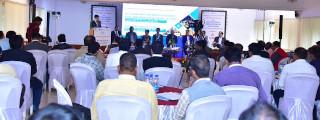Sectoral Technology and Solutions - Refinery
Carbon Capture Technology
A patented carbon capture technology using CDRMax™ process which allows to capture more carbon at the lowest cost, all while meeting strict environmental criteria. The CDRMax™ process captures carbon dioxide (CO2) from the industrial flue gases or off-gases emitted from power plants, boilers, kilns and chemical facilities. The process produces CO2 with purities ranging from 95% to 99%, which can then be sold, re-used, or sequestered. The CDRMax™ process utilises our CO2 capture technology, proprietary solvent, process equipment, and advanced heat integration to significantly reduce both capital and operating costs.
Carbon Clean
Address: 3rd floor, 3 Valentine Place, London, GB, SE1 8QH
State: London
National/International: International
✆ +44 (0)20 8164 7400
Chemical-Resistant Nanofiltration Membranes
The new generation of nano-filters is dramatically reducing energy consumption and pollution globally by enabling the most effective chemical separation at a molecular level, without the traditional use of heat.
Seppure
Address: The Galen, 61 Science Park Road, #03-09 Singapore 117525
State: Singapore
National/International: International
📧 farahani[at]seppure[dot]com
🌐 https://seppure.com/
Chemicals Circular Economy
Current olefin production is almost exclusively based on catalytic cracking of fossil resources (e.g. natural gas, crude oil). Olefins production consumes 60%+ of global primary petrochemicals feedstocks. It is also an energy intensive process, accounting for 30% of the chemical’s sector total energy use. The new circular chemical economy will enable the production of olefins and their complementary feedstocks from captured CO2, biomass and recycled waste driven by renewable energy, removing its dependency on fossil fuels.
The National Interdisciplinary Centre for the Circular Chemical Economy (CircularChem)
Address: Loughborough University, Loughborough, Leics., LE11 3TU, UK
State: Loughborough
National/International: International
📧 circular[dot]chemical[at]lboro[dot]ac[dot]uk
🌐 https://www.circular-chemical.org/
Continuous flow processes
Manufacturing chemicals in continous flow can eliminate or reduce solvents, allow for substantial process intensification, and open possibilities for efficient reaction shortcuts. The major way to save energy in continuous flow processing is straightforward heat recovery. This is difficult or near-impossible in batch. Between 60-90% of the heat put into the reactor is recoverable from the outlet stream using a simple heat exchanger when using continuous flow. This heat can be used to heat the ingoing feed stream before it reaches the reactor.
Stoli Catalysts
Address: Stoli Chem, Prince Phillip Building, Wellesbourne Campus, Wellesbourne, CV35 9EF, UK
State: Wellesbourne
National/International: International
📧 stolichem[at]stolichem[dot]com
🌐 https://stolichem.com/
Industry 4.0 Wireless Energy Solutions
Industry 4.0 Wireless Energy Solutions offering end to end solution, right from LT main panel up to individual machines. While panel-level wireless sensors give an overview of energy consumption at the macro-level, the circuit-level / machine-level wireless sensors monitor energy consumption at each electrical phase (R/Y/B) of a machine. This will help in reducing inefficiencies/ wastages in any system but also machine level breakdowns through predictive maintenance. As the complete solution is wireless, the installation and software integration are executed within minutes and the whole system/ facility can be digitalized in no-time. The clip-on sensors are self-powered (no battery/ electrical source) and maintenance-free.
Centrica
Address: via website
National/International: International
📧 anand[at]hitechfe[dot]in
🌐 https://www.centricabusinesssolutions.com/
Optimised catalysts
In the refining and petrochemical industry, catalysts are essential in producing the desired products in an efficient and sustainable manner. The optimized catalysts are developed to enhance the performance of these processes, leading to higher quality products, lower energy use and less waste. The processes are cost-effective, easily scalable and fully non-hazardous for the environment and people.
Zeopore
Address: Interleuvenlaan 23 3001 Leuven Belgium BE 0687.492.151
State: Belgium
National/International: International
📧 info[at]zeopore[dot]com
🌐 https://www.zeopore.com/
Photocatalyst
Photoreactor technology is the culmination of more than 30 years of plasmonics and nanotechnology research out of Rice University. The combination of reactor design and photocatalytic nanoparticles enable light-driven chemical reactions at unprecedented efficiency. These disruptive innovations eliminate the need for combustion in the chemical reaction chain, enabling the production of zero-emission hydrogen, green ammonia, and other foundational chemicals. Photoreactors are even capable of processing harmful carbon dioxide into high-value feedstocks like methanol, syngas, and formic acid.
Syzygy Plasmonics
Address: 3250 South Sam Houston Parkway East, Houston, TX 77047, US+1 346.571.3647
State: Texas
National/International: International
📧 info[at]plasmonics[dot]tech
🌐 https://plasmonics.tech/
Roto Dynamic Reactor (RDR) technology
Traditionally, Olefins are produced by steam cracking ethylene or naphtha at extremely high temperatures in massive cracker furnaces. The core reacting mixture is heated in tubular coils from the outside of the reaction zone through tube walls using non-renewable fossil fuels and massive amounts of energy. It is this part of the process that is the main source of CO2 emissions in olefin production. Instead of heating the feedstock mixture from outside the reaction zone, RDR's high-velocity rotor blades create thermal energy to heat the mixture inside the reaction zone – quickly and much more efficiently. RDR uses renewable electric power, making it the only technology capable of cutting 100% of direct process emissions.The revolutionary Roto Dynamic Reactor (RDR) technology electrifies this previously fossil-heavy process, reducing process emissions by 100%. Further, utilization of recycled and bio-based feedstocks has been increased, thereby further decreasing the lifecycle CO2 footprint of plastics.
Coolbrook
Address: Pieni Roobertinkatu 9 00130 Helsinki Finland
State: Finland
National/International: International
📧 info[at]coolbrook[dot]com
🌐 https://coolbrook.com/technology/rdr/



